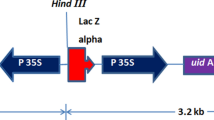Abstract
Commercial peppermint (P) (Mentha × piperita L. ev. Black Mitcham), native spearmint (NS) (M. spicata L.) and Scotch spearmint (SS) (M. × gracillis Sole cv Baker) petioles and orange mint (OM) (M. citrata Ehrh.) leaf disks were cocultivated with a number of Agrobacterium tumefaciens strains. P, SS and OM initiated tumor-like callus tissue on growth regulator-free MS medium after cocultivation with strain A281, a hypervirulent agropine strain containing Ti plasmid pTiBo542. Callus did not initiate from explants cocultivated with strain C58, a virulent nopaline strain; with A 136, a plasmidless strain, or from uninoculated controls. A281-derived callus was maintained on growth regulator-free medium in the absence of antibiotics for up to two years with no bacterial outgrowth. No shoots regenerated from any of the tumors on regeneration medium. Five of seven OM callus lines assayed gave a positive signal for agropine. DNA extracted from OM tumor tissue hybridized to a DNA probe specific to the T-DNA region of pTi plasmid. Genomic Southern analysis of DNA from tumors of P and SS indicated that one to a few copies of the T-DNA integrated into the mint chromosomes. PCR amplification of genomic DNA with primers specific for one of the T-DNA encoded genes yielded fragments that, when analyzed by restriction enzyme mapping and on Southern blots, corresponded to the cytokinin biosynthesis gene ipt. These results demonstrate transformation of three species of mint and the potential for using A. tumefaciens to transfer economically important genes into commercial mint cultivars.
Similar content being viewed by others
Abbreviations
- BA:
-
benzyladenine
- CW:
-
coconut water
- Cef:
-
cefotaxime
- P:
-
peppermint
- SS:
-
scotch spearmint
- NS:
-
native spearmint
- OM:
-
orange mint
- BM:
-
basal medium
- MS:
-
Murashige and Skoog (1962)
- PAR:
-
photosynthetically active radiation
- CTAB:
-
hexadecylatrimethylammonium bromide
- ipt :
-
isopentenyl transferase
References
Berry C (1991) Mint improvement through tissue culture, irradiation and agrobacterium-mediated transformation. M.S. Thesis, Univ. Delaware
Hammerschlag FA, Owens LD & Smigocki AC (1989) Agrobacterium-mediated transformation of peach cells derived from nature plants that were propagated in vitro. J. Amer. Soc. Hort. Sci. 114: 508–510
Hood EE, Helmer GL, Fraley RT & Chilton MD (1986) The hypervirulence of Agrobacterium tumefaciens A281 is encoded in a region of pTiBo542 outside of T-DNA. J. Bacteriology 168: 1291–1301
Kelm P, Olson TC & Shoemaker RC (1988) A rapid protocol for isolating soybean DNA. Soybean Genet. Newslett. 15: 150–152
Lacy ML, Stephens CT, Green RJ & York AC (1984) Mint production in the Midwestern United States. North Central Regional Extension Publication No. 155. (pp 1–18) Cooperative Extension Service, Michigan State University, MI
Murashige T & Skoog F (1962) A revised medium for rapid growth and bioassays with tobacco tissue cultures. Physiol. Plant. 15: 473–497
Spencer A, Hamill JD & Rhodes MJC (1990) Production of terpenes by differentiated shoot cultures of Mentha citrata transformed with Agrobacterium tumefaciens T37. Plant Cell Rep. 8: 601–604
Smigocki A & Hammerschlag F (1991) Regeneration of plants from peach embryo cells infected with shoots mutant strain of Agrobacterium. J. Amer. Soc. Hort. Sci. 116: 1092–1097
Steffen A, Eriksson T & Schieder O (1986) Shoot regeneration of mesophyll protoplasts transformed by Agrobacterium tumefaciens, not achievable with untransformed protoplasts. Theor. Appl. Genet. 72: 135–140
Van Eck JM & Kitto SL (1992) Regeneration of peppermint and orange mint from leaf disks. Plant Cell Tis. Org. Cult. 30: 41–49
Watson B, Currier TC, Gordon MP, Chilton MD & Nester EW (1975) Plasmid required for virulence of Agrobacterium tumefaciens. J. Bacteriology 123: 255–264
Author information
Authors and Affiliations
Additional information
Received for publication 1994. Published as Miscellaneous Paper No. 1482 of the Delaware Agricultural Experiment Station. Contribution No. 317 of the Department of Plant and Soil Sciences. Mention of trade names in this publication does not imply endorsement by the Delaware Agricultural Experiment Station of products named, nor criticism of similar ones not named.
Rights and permissions
About this article
Cite this article
Berry, C., Van Eck, J.M., Kitto, S.L. et al. Agrobacterium-mediated transformation of commercial mints. Plant Cell Tiss Organ Cult 44, 177–181 (1996). https://doi.org/10.1007/BF00048197
Received:
Accepted:
Issue Date:
DOI: https://doi.org/10.1007/BF00048197




